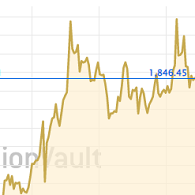US Debt? Stop Worrying. It's Fine
Everything is fine. Repeat, everything...
TOTAL U.S. DEBT now stands at $33.6 trillion. But this is fine,
writes Tim Price at PriceValuePartners.
83% of US tax revenue in the last fiscal year was spent solely on social security,
Medicare, the military, and interest
on the national debt. But this is fine.
In mid-2020, the yield on the 10 year
US Treasury bond – essentially,
the global benchmark 'risk-free rate' – was at approximately 0.5%. It now stands at 5%. A surge higher
of such magnitude in such a
short period of time has probably never happened before. But this is fine.
For
the six months to August,
China, the second-largest foreign creditor to the United States, sold more than $45 billion of its
Treasury holdings, according to
official data. But this is fine.
Meanwhile the US Federal Reserve, which owns a
large amount of US government
debt that it has bought to support bond markets during periods of financial volatility, has begun to
shrink the size of its balance
sheet, reducing demand for US Treasuries just as the government needs to borrow even more. But this is
fine.
Money supply growth in the US, on a monthly basis, is negative for the first time since the 1950s; on an
annual basis, it is negative
for the first time since the Great Depression. But this is fine.
Three of the
four largest bank failures in
US history took place during the early summer. More than $500 bn has had to be written off since March.
But this is fine.
When Alan Greenspan was Chairman of the Federal Reserve in 2001, he enjoyed a Gallup
confidence level of 74%. Jerome
Powell currently enjoys a confidence level of 36%. But this is fine.
From
'Grant's Interest Rate
Observer':
"We face a possible Dollar inflation uncertainty nightmare," writes
the economist Charles W.
Calomiris, in – of all places – a quarterly journal of the Federal Reserve System. The worst imaginable
consequences of the
subordination of monetary management to the public debt is the subject before the house.
"Fiscal Dominance
and the Return of Zero-Interest Bank Reserve Requirements" is the unsensational headline over the essay
in which Calomiris advances
his pulse-pounding conclusions. In it, the Henry Kaufman Professor of Financial Institutions Emeritus at
the Columbia Business School
speculates about a looming fiscal crisis, a buyers' strike against Treasury securities and the
monetary-policy response to this
imagined catastrophe. Suffice it to say that it isn't bullish.
"Many readers,
not remembering the failed
Treasury-bond auction of Aug. 1, 1973, will doubt that a creditors' strike is even conceivable. However,
there's no quarrelling with
the proposition that the Treasury is borrowing trouble. Calomiris chooses to preface his article with an
excerpt from the Feb. 16
Financial Report of the United States Government, which reads:
"Under current
policy and based on this
report's assumptions, [government debt relative to GDP] is projected to reach 566% by 2097. The
projected continuous rise of the
debt-to-GDP ratio indicates that current policy is unsustainable."
Still,
everything is fine...
...but just in case everything isn't fine, now would be a good time to reassess what you
own in your investment
portfolio, and why you own it.













 Email
us
Email
us
